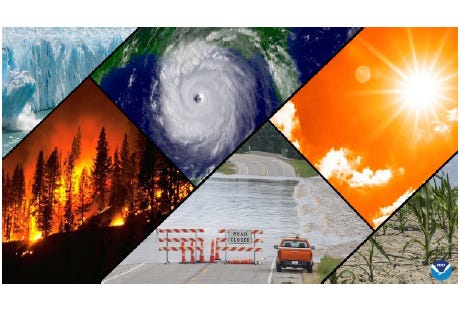Forecasting is Prevention - Dismantling Climate Science is Leaving Us Exposed
The political war on climate science isn't just ideological—it's a public safety crisis in the making.
In the United States, billion-dollar disasters used to be rare. Now they’re routine.
In 2024, America suffered 27 separate billion-dollar disasters, from hurricanes and tornadoes to floods and wildfires. The cost? Over $183 billion. The toll? Hundreds of lives lost, thousands displaced, and entire communities erased. These aren’t isolated tragedies. They’re multiplying and intensifying.
Behind the scenes, while the climate crisis accelerates, another crisis festers in silence - the dismantling of the very systems designed to warn and protect us. The rollback of U.S. climate science, particularly within agencies like the National Oceanic and Atmospheric Administration (NOAA), the Environmental Protection Agency (EPA), and the National Institutes of Health (NIH), has left the nation increasingly blind to the dangers ahead. It’s a slow-motion unraveling with consequences for lives, economies, and America’s global standing.
When Forecasts Are Political Casualties
The National Oceanic and Atmospheric Administration (NOAA) is the gold standard in weather forecasting. From hurricane paths to wildfire conditions, NOAA's satellites, sensors, and scientists provide critical early warnings that save lives and protect infrastructure. But NOAA isn’t just about sunny skies and weekend rain. It’s the frontline defense in a warming world.
During the Trump administration, however, NOAA was targeted along with other science-based agencies. Some examples –
· Climate research programs were canceled or defunded.
· Entire datasets and websites were deleted.
· Career scientists were fired or reassigned.
· Climate-related health research at NIH was quietly killed.
· The EPA pursued a rollback of the 2009 greenhouse gas endangerment finding, undermining its ability to regulate emissions.
Daniel Swain, a climate scientist at UCLA, starkly predicted, “There will be people who die in extreme weather events and weather-related disasters who would not have otherwise.”
One particularly alarming threat was the potential dismantling of NOAA’s climate monitoring and forecasting systems. While some programs survived due to public outcry and bureaucratic resistance, the very consideration of defunding core forecasting functions showed how vulnerable scientific institutions had become to political ideology.
The dismantling of government science doesn’t just affect long-term climate models. It affects your ability to evacuate your home in time. It determines whether firefighters are pre-positioned before a wildfire ignites. It shapes how hospitals prepare for power outages and flood surges. These are local, immediate, real-world consequences.
The Consequences: Delayed Warnings, Greater Harm
Without accurate forecasting, more people suffer and die.
Whether it’s a slower response to a tornado outbreak in the Midwest, underestimating the path of a hurricane barreling toward the Gulf Coast, or failing to predict wildfire conditions in a drought-stricken California valley, time is everything. Seconds count. Days matter. Forecasting is prevention.
The attack on climate science didn’t spare the National Institutes of Health. A key program researching the health impacts of climate change was terminated. But the connections between climate and health are profound.
Extreme weather events, intensified by climate change, pose a significant threat to human health, causing physical injuries, acute illnesses, and worsening chronic conditions. Vulnerable populations, including older adults, low-income communities, and those with preexisting health issues, face disproportionate risks. Physical injuries from debris, collapsing structures, or floods are common, and drowning during flash floods is a major cause of weather-related death. Heat-related illnesses surge during prolonged heatwaves, and medication interactions exacerbate risks. Infectious diseases spread through contaminated floodwaters, and vector-borne diseases expand as warmer temperatures broaden mosquito habitats. Respiratory and cardiovascular diseases are worsened by wildfire smoke and mold growth in flood-damaged buildings. Mental health impacts include acute stress, PTSD, climate anxiety, and chronic condition complications. Low-income communities often lack air conditioning, safe housing, or transportation for evacuations. Proactive measures are crucial to mitigate these crises.
Denial Isn’t Free: The Economic Toll
Denial of climate change isn’t free. The economic burden is massive and growing. Accurate forecasts aren’t just about safety. They’re economic lifelines. Farmers rely on NOAA data to plant crops, airlines use it to route flights, and insurers depend on it to price risk.
Recover efforts after a disaster could slow, compounding costs for taxpayers. The Federal Emergency Management Association (FEMA) approved over $1.2 billion in aid after recent hurricanes, but Project 2025 proposals aim to transfer disaster response to states ill-equipped to manage it.
The Global Stage: America Steps Back
There’s a geopolitical cost, too.
When the U.S. exited the Paris Climate Agreement, the world didn’t stop. China, the European Union, and other global players doubled down on renewables, green tech, and emissions reduction. While U.S. scientists were being reassigned or silenced, international researchers moved forward. Climate denial isn’t just bad for the planet. It’s bad for U.S. competitiveness, innovation, and leadership.
Everyone Should Care
If you live in a coastal city, climate science matters to your flood insurance and home value.
If you’re a farmer or rancher, it matters to your growing season and crop viability.
If you’re a parent, it matters to your child’s air quality and summer heat exposure.
If you’re a firefighter, emergency planner, or nurse—it matters to your job, your safety, and your ability to protect others.
Where We Go From Here
We need to:
· Reinvest in NOAA and its forecasting infrastructure.
· Restore and expand federal climate-health programs at NIH, CDC, and HHS.
· Protect scientific integrity policies across all federal agencies.
· Rejoin and lead in global climate efforts, reclaiming a position of influence.
· Educate the public about the connection between climate science and public safety.
However, undoing the damage won’t be easy. The time and institutional knowledge lost may be impossible to fully recover. In an era of accelerating climate consequences, prevention isn’t a luxury. It’s the only rational choice.
When the next hurricane forms, the next wildfire sparks, or the next flood rises, don’t ask why help didn’t come sooner. Ask who erased the forecast.



